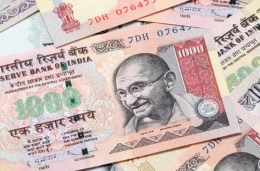Trading the Indian Rupee

| Broker | Bonus | More |
|---|
A Quick History of the Indian Rupee
The first mention of an Indian currency is from a 6th century BC text referring to coins punch-marked with symbols called rupa. There are also mentions in the 4th century BC of silver coins featuring symbols called rupyarupa. The Islamic ruler Sultan Sher Shah Suri issued a coin in 1540 made from silver, with a standard weight. This was given the name Rupiya, and remained in use even in the time of the British occupation during the 18th century. It was during the 1700s that the Bengal Bank and Bank of Hindustan were established, and began issuing paper currency called Rupees. The gold standard was adopted in 1898 and the Rupee was pegged to the British Pound Sterling.
The Paper Currency Act was passed in 1861, giving the government the monopoly on issuing the Rupee across the entire country. The Reserve Bank of India was established in 1935 as the country’s central bank, with its location in Calcutta. It was given the responsibility of issuing the nation’s bank notes in 1938. When India gained its independence from Britain in 1949, the Rupee began to be issued in Hindi, using an image of Mahatma Gandhi. In 1957, sub-units of the currency were also issued, called Naya Paisa, with 100 of them making up one Rupee.
India’s National Economy
India has the fourth biggest economy in the world according to its GDP. It also has one of the world’s largest populations, with over one billion citizens. India has an emerging open-market economy, and the government are trying to liberalise their policies, placing less control on foreign trade, industry regulation and investment. The country’s main industries include chemicals, textiles, food processing, transportation equipment, steel, cement, petroleum, mining, machinery, pharmaceuticals and software. India’s economy is diversified, with its basis on industry and agriculture on both a small and large scale. India’s farming industry has grown by over 5% per year, and around 50% of the country’s population is employed by the agriculture sector. India’s service sector is also growing, which benefits the nation’s economy. Information technology services are growing, as are the software industry and business outsourcing services. The service industry is currently responsible for around 60% of the country’s economic growth.
In recent years, however, growth has started to weaken due to the slowdown in the global economy, and uncertainties exhibited by investors over India’s current account and fiscal deficits. The country also faces challenges due to its overstressed education system, migration from the countryside to the cities, and deficient infrastructure, in particular a poor power-generation network. The outlook for growth is positive, however, thanks to the young population, strong investment and savings rates, and an increased amount of integration into the world economy. India’s main trading partners include the United Arab Emirates, America, China, Hong Kong, Saudi Arabia, the UK, Singapore, Vietnam and Sri Lanka.


